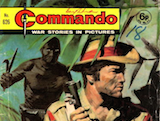'What are you waiting for, Diggers?' The ANZAC image in Commando comics
Abstract
For generations of Australians and New Zealanders, Commando comics have provided a consistent image of their ancestors at war. The image is one of men, who are inevitably tall, bronzed, shirtless, contemptuous of authority and their ability, as warriors such—in memory at least—that their mere presence on the battlefield is enough to have the Germans crying ‘Donner und blitzen!’, and the Italians ‘Sapristi!’ or the Japanese ‘Aieee!’ But how accurate is this depiction of Australians and New Zealanders? How well does a Scottish comic—often employing artists from Argentina and other countries—portray the ANZACS? And how did a Scottish comic come to dominate the image of Australians and New Zealanders at war for so long?
Downloads
Metrics
References
Arts and Humanities Research Council (2016). New AHRC film looks ahead to the 2014 WW1 commemorations. Retrieved from www.ahrc.ac.uk/News-and-Events/News/Pages/Comics-and-the-World-Wars-A- Cultural-Record.aspx.
Berry, J. 2014. The underside of the undershirt: Australian masculine identity and representations of the undershirt in the ‘Chesty Bond’ comic-strip advertisements. Critical Studies in Men's Fashion, 1(2), 147-159.
Burdan, A. (2012). Te tohu toa/Victory at Point 209.Wellington, NZ: Huia Publishers.
Chapman, J. (2011). Representation of female war-time bravery in Australia’s Wanda the War Girl. Australasian Journal of Popular Culture 1(2), 153-163.
Chapman, J., & Ellin, D. (2012). Multi-panel comic narratives in Australian First World War trench publications as citizen journalism. Australian Journal of Communication, 39(3), 1-22.
Chapman, J. (2013.) Comics and the world wars: A cultural record. Retrieved from www.janechapman.co.uk/page14.htm
Chapman, J., Hoyle, A., Kerr & A. Sherif A. (2015). Comics and the world wars. Basingstoke, UK: Palgrave Macmillan.
Clarkson, A. (2008). Virtual heroes: Boys, masculinity and historical memory in war comics 1945–1995. Thymos, 12(2), 175-185.
Comicsdownunder (2007). Unmasking the phantom commando. Retrieved from http://comicsdownunder.blogspot.com.au/2007/09/unmasking-phantom-commando.html
Commando Comics home page (n.d.). Available at www.commandocomics.com/
Coville, J. The Comic Book Villain, (n.d.). Dr Fredric Wertham, MD. Retrieved from www.psu.edu/dept/inart10_110/inart10/cmbk4cca.html
Digparty, digplanet log (2016). Learn and talk about Chesty Bond. Retrieved from
www.digplanet.com/wiki/Chesty_Bond
Dolan, H. & Gardiner, M. (2012). Gallipoli: The landing. Melbourne, Vic: Z Books.
Dolan, H., Howell, D. & Tea, S. (2012). Kokoda: That bloody track. Melbourne, Vic: Z Books.
Dolan, H. & Threlfall, A. (2015). Reg Saunders, an indigenous hero. Sydney, NSW. New South.
Finnane, M. (1989). Censorship and the child: Explaining the comics campaign. Australian Historical Studies, 23(92), 220-240.
Foster, J. (1991). From ‘Ulla Dulla Mogo’ to ‘Serene Azure Vault of Heaven’: Literary style in Australian children's comic books. The Journal of Popular Culture, 25(3), 63- 77.
Foster, J. (1998). A social history of Australia as seen through its children's comic books. Journal of Australian Studies, 22(59), 165-172.
Foster, J. (1999). The slow death of a monochromatic world: The social history of Australia as seen through its children’s comic books. The Journal of Popular Culture, 33(1), 139-152.
Foster, S. (1998). David Low. New Zealand Dictionary of Biography, Vol 4. Wellington, NZ: Ministry for Culture & Heritage.
Gibson, M. (2008). What you read and where you read it, how you get it, how you keep it: Children, comics and historical cultural practice. Popular Narrative Media, 1(2), 151–167.
Gray, B. (2017). Canadian comics: A brief history. In Bramlett B; Cook R and Meskin, A. (Eds.), The Routledge companion to comics (pp. 62-69). New York and London: Routledge.
Johnson, N., Middleton, M. & Tajfel, H. (1970). The relationship between children's preferences for and knowledge about other nations. British Journal of Social and Clinical Psycholog, 9(3), 232–240.
Juddery, M. (2007, November 16). Aussie heroes left to history. The Courier Mail.
Kinnaird, A. (2013). From earth’s end: The best of New Zealand comics. Auckland, NZ: Godwit.
Laurie, R. (1999). Masculinities and war comics. Journal of Australian Studies, 23(60), 114-121.
Lealand, G. (2016). Bodgies and widgies and rabbits: New Zealand in the 1950s. New Zealand Memories. October/November.
Low, G. (Ed.). (2007). Anzacs at war. Sydney, NSW: Harper Collins.
Low, G. (2011). 50 years a home for heroes. London, UK: Carlton.
Lindesay, V. (1970). The inked-in image—a social and historical survey of Australian comic art. Richmond, Vic: Hutchinson.
McBeth, J. (2013). Behind enemy lines! Britain's last war comic Commando for action and adventure moves printing... to Germany. Retrieved from www.dailymail.co.uk/news/article-2345109/Britains-sole-surviving-war-comic-Commando-printed-Germany-publishers-announce.html#ixzz3774Jsefa
Maurice Bramley. (2016). Retrieved from http://en.wikipedia.org/wiki/Maurice_Bramley
Milne, R. (2008, March 2). Anzac comic in the gun. The New Zealand Herald.
Moon, P. (2008). This horrid practice. Wellington, NZ: Penguin.
Mutard, B. (2008). The Sacrifice. Allen and Unwin: Melbourne.
Ogg, A. (2014). ‘For you, Tommy, the war is never over.’ Punk & Post Punk, 2(3), 281-304.
Panozzo online. (2001). Vale Jim Russell. Available at http://thecartoonfactory.com.au/russell.html
Pocket War Comics. (2011). War picture library 135 The big arena. http://pocketwarcomics.blogspot.co.nz/2011/07/war-picture-library-135-big-arena.html
Rech, M. (2014). Be part of the story: A popular geopolitics of war comics aesthetics and Royal Air Force recruitment. Political Geography, 39: 36-47.
Ryan, J. (1979). Panel by panel: An illustrated history of Australian comics. Melbourne, Vic.: Cassell.
Scott C. (2011.) Comics and conflict: War and patriotically themed comics in American cultural history from World War I through the Iraq War. Unpublished PhD thesis, Loyola University, Chicago.
Slane, C. & Elliott, M. (2011). Nice day for a war. Auckland, NZ: Harper Collins.
Walters, G. (2011). Banzai! Eat lead, Fritz! Or why, for Commando comic, the war is NEVER over. Retrieved from www.dailymail.co.uk/news/article-2034167/GUY-WALTERS-Banzai-Eat-lead- Fritz-Or-Commando-comic-war-NEVER-over.html
Worcester, K. (2015). Foreword. In Chapman, J., Hoyle, A., Kerr and A. Sherif A. (Eds.), Comics and the world wars. Basingstoke, UK: Palgrave Macmillan.
Z Beach True Comics (n.d.). Available at www.zbeach.com.au/

Copyright (c) 2017 Philip Cass, Jonathan Jack Ford

This work is licensed under a Creative Commons Attribution-NonCommercial 4.0 International License.















